Aventon Pace 4 Review | Cruise Swiftly with Security & Style
Aventon’s latest take on a city cruiser feels fresh and youthful while hosting an impressive suite of 4G-enabled security and ride customization features.
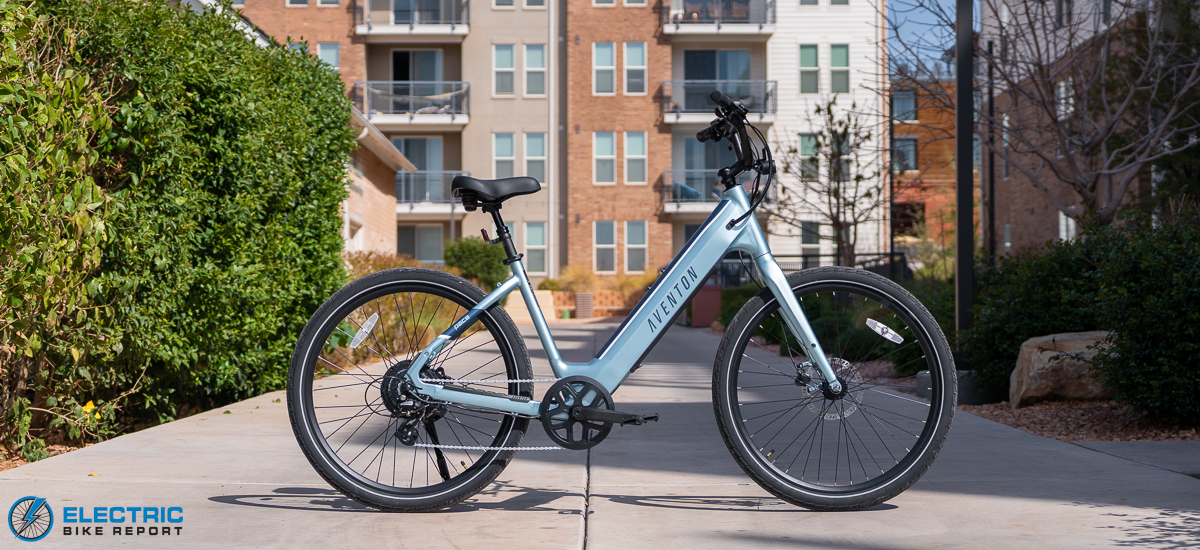
Historically, the Pace city cruiser has been one of Aventon’s most iconic rides; it’s the original model that many other brands imitated but never quite matched. Now, having received the same treatment as many of the brand’s latest releases, the Pace 4 widens the gap even more with a refreshed look and feel—and some big upgrades in technology.
The Pace 4 features a largely weld-free gravity cast frame, giving it a smooth and streamlined appearance. It also traded the model’s previously curved Dutch cruiser handlebars for straighter BMX-style bars, resulting in a sporty-yet-comfortable style.
The bike is equipped with Aventon’s 4G-enabled ACU module (short for Aventon Control Unit). Through the brand’s mobile app, the ACU allows users to monitor the bike’s location, set up security features such as a wheel lock and motion detection/alarm system, activate geofencing boundaries, and even remotely disable the bike in the event of theft.
While Aventon dropped the “500” portion of the Pace’s moniker (a change that makes it much easier to number each bike’s generation), the new-and-improved model still hosts a 500W rear hub motor paired with a torque sensor. We noticed quickly that the bike’s updated programming, however, made it feel more responsive and natural than ever.
Having thoroughly tested each previous version of the Pace, we were faced with one question: Is this the best version of the Pace to date? Continue to our full review below to find out how it fared in our series of standardized performance tests!
Class 2 (throttle to 20 mph)
Class 3 (pedal assist to 28 mph)
 Pros
Pros- The Pace 4 has a sporty feel with a big focus on comfort. It has a cushy cruiser-style saddle on a suspension seatpost to keep the ride smooth.
- Its motor output feels responsive and natural, thanks to Aventon’s pairing of a 500W motor and torque sensor. Users can also customize motor output through the Aventon app!
- The integrated ACU module gives owners remarkable control over the bike’s security. 4G connectivity enables location tracking, geofencing, a motion detection and alarm system, a wheel lock, and more!
- It has incredible range! The bike’s 733 Wh battery and efficient motor gave us one of the best results yet from a 500W commuter.
- The Pace 4’s handling is superb, thanks to its rigid fork, BMX-style handlebars, and 27.5×2.1” tires.
- Its step-thru frame and sub-17” standover height make for easy mounting and dismounting without the need to lift a leg over the saddle.
- Security features aside, we found the bike intuitive and simple to operate, with three pedal assist levels and a relatively straightforward cockpit layout.
 Cons
Cons- We liked the updated feel, but previous Pace owners looking to upgrade may be surprised by the new model’s longer reach and the absence of Dutch-style handlebars.
- We hoped the bike would include brake lights along with its turn signals for added safety.
- Battery: Removable Internal Lithium-ion. 36V, 20Ah, 733Wh, LG 21700 cells
- Display: BC147
- Motor: 36V, 500W (Peak 864W)
- Headlight: Integrated LED
- Taillights: Integrated LED
- Pedal Assist: Throttle + Pedal Assist with Ride Tune Capabilities
- Claimed Range: Up to 70 Miles
- Throttle:Aventon LH Handlebar Mounted
- App:Aventon App
- UL Certification:UL 2271 Certified
- Claimed weight: 53 lbs
- Tested Weight: 61.5 lbs (with 8.5 lb battery)
- Rider height range: 4’11”-5’7” (S/M), 5’7”-6’1” (L/XL)
- Total payload capacity: 300 lbs
- Brakes:Tektro Hydraulic w/ E-Cutoff
- Fenders:Not Included
- Fork:Rigid Aluminum Fork
- Frame: 6061 Aluminum, Gravity Cast front triangle, Rear spacing 142 mm
- Drivetrain:Shimano Altus 8-Speed, 48T chainring, 12-32T cassette
- Grips: Aventon Ergonomic Comfort lock on grips
- Saddle: Aventon Saddle
- Handlebar: BMX Style Aluminum 31.8mm, 720mm
- Kickstand: Included
- Pedals: 9/16” composite platform
- Tires: 27.5” x 2.1”
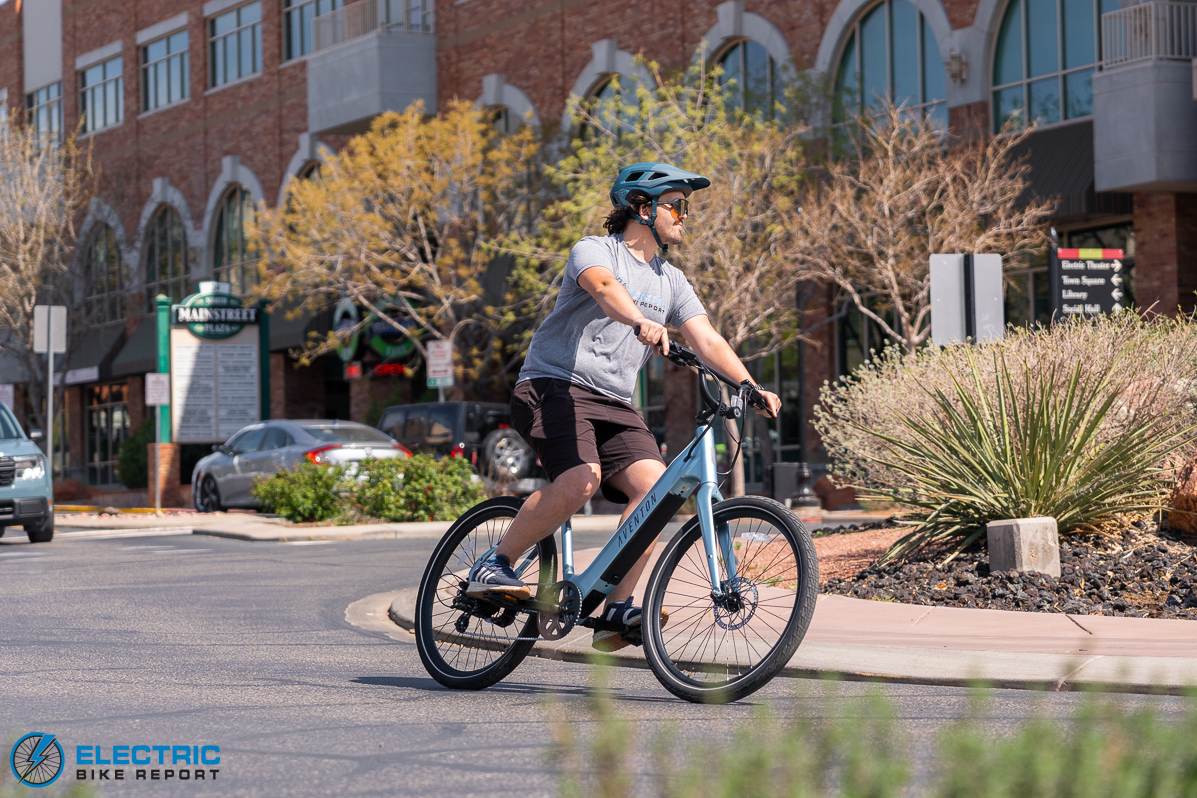
Great handling has been a consistent feature across all Pace models; the Pace 4 continues the trend with crisp cornering and an agile feel.
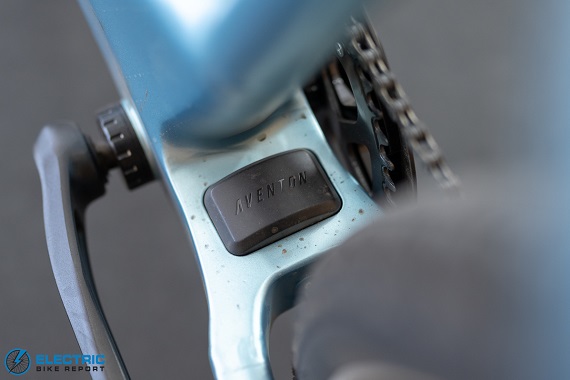
The ACU module is seated into the frame’s rear triangle behind the seatpost.
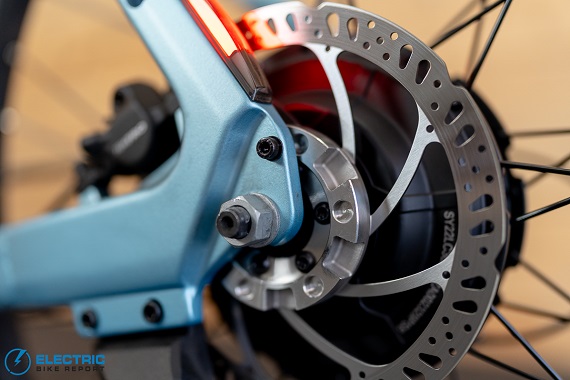
The aluminum plate on the rear wheel serves as one piece of the locking mechanism.
Aventon Pace 4 Review: Speed Test
As shown in the graph above, I tested the bike with a Class 2 maximum speed of 20 mph and with a Class 3 maximum of 28 mph. The bike felt and performed similarly in both tests, with the main difference being its ability to reach higher speeds in the Class 3 test. In both cases, the bike pedaled responsively up to its respective maximum speeds.
With a torque sensor, the Pace 4’s motor can change its output based on the amount of effort applied to the pedals. As such, my results will likely differ from yours to some extent, though part of my evaluation process is finding the speeds the bike seems to naturally want to occupy.
I found that the lowest assist level, Eco mode, kept a relatively light level of power for a remarkably analog-like feel. The Pace’s highest power level, Turbo mode, delivered substantial power that made pedaling extremely easy. Finally, the mid-level setting, Sport mode, felt like it skewed more toward Turbo than Eco, which is reflected in my test data.
Based on this test, Eco seemed appropriate for conserving power and getting a light workout. I recommend Sport for general riding, as pedaling felt easy even on moderate hills. Turbo felt best for climbing more extreme hills and more easily reaching Class 3 speeds.
As another caveat, we tested the bike with its default settings, but its motor output can be customized using the RideTune feature in the Aventon App. This feature allows users to change the motor’s torque and peak wattage and the torque sensor’s sensitivity. My results would likely have been different if I’d changed any of these parameters prior to the test.
When testing the Pace’s throttle, it started gradually and then built steadily in speed until reaching the maximum of 20 mph. It felt controlled without being sluggish, which fits the theme and general feel of the bike.
Overall, the bike performed well here with intuitive programming, an easy-to-use interface, responsive and natural-feeling power delivery, and an approachable and effective throttle. It earned an emphatic two thumbs up!
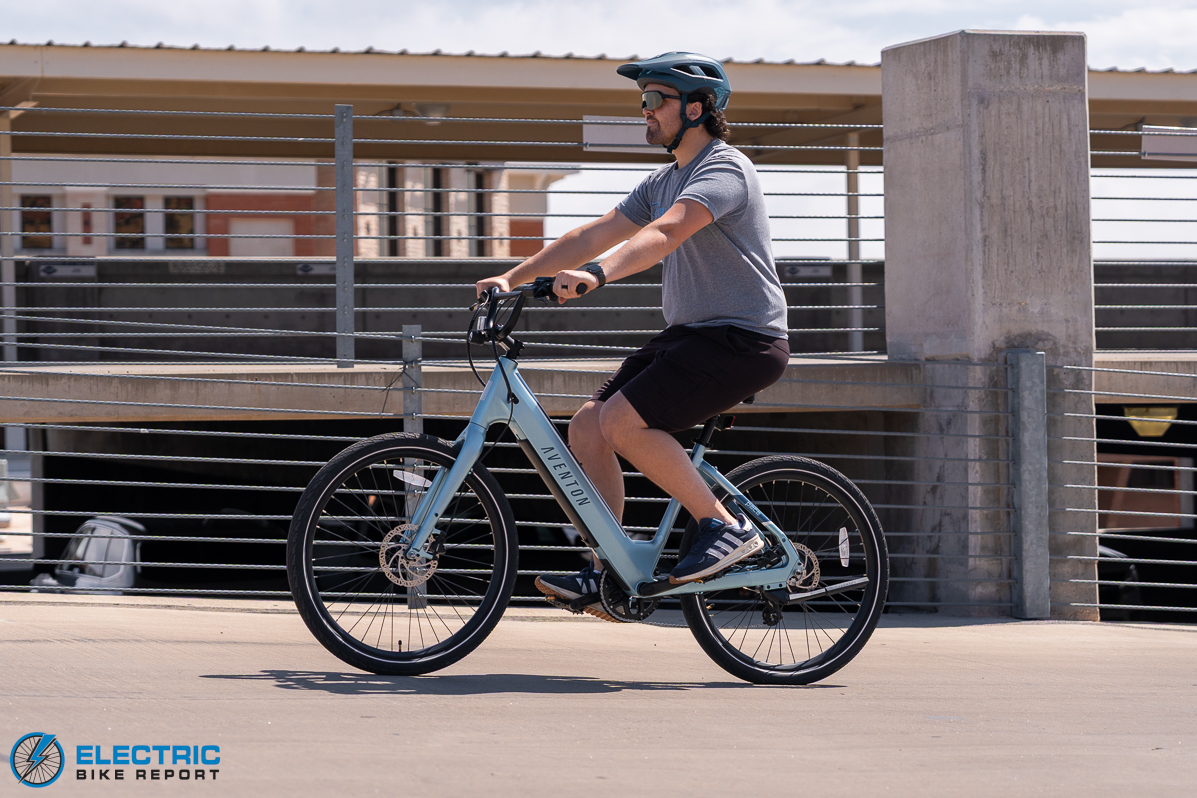
The Pace 4 was designed with leisure in mind, but it’s also highly capable of long commutes.

The 500W motor is paired with a torque sensor to deliver power quickly and intuitively based on the rider’s effort.

We found the 8-speed Shimano Altus drivetrain to be effective at both Class 2 and Class 3 speeds.
Aventon Pace 4 Review: Range Test

Our Range test uses the process explained above to determine real-world minimum and maximum range values for a single battery charge. In both tests, we rode the bike until around 5% of the battery charge remained, as that was the point where the motor no longer offered meaningful pedal assist.
With its 733 Wh battery, our test riders (myself included) traveled 40.9 miles in Turbo mode and 85.6 miles in Eco mode. Both of these results were well above average when compared with similar commuter e-bikes we’ve tested with 500W hub motors.
The bikes used for comparison averaged 30.3 miles with their highest level of pedal assist while reaching 55.5 miles on average with their lowest practical power level. The Pace 4’s tests gave us an additional 14.5 to 16.5 miles, depending on the pedal assist setting.
Battery capacity is the main difference between the Pace 4 and the others we compared it with; those bikes had batteries with an average of 640 Wh vs. Aventon’s 733 Wh power supply. Subsequently, the Pace had an additional 80 watt hours in its “gas tank,” making it easier to travel longer distances.
The bike’s torque sensor also likely helped to extend its range. With variable power output, the Pace’s motor was naturally more efficient than others with steady flow that were paired with cadence sensors.
We estimated the Pace would travel roughly 25 miles over the course of 86 minutes in its Turbo mode test based solely on its motor and battery specs. Our real-world results reinforce the higher efficiency from the torque sensor.
As expected, our testing shows that riders who are able to stick more often with Eco or Sport modes will get more miles out of the bike than those using primarily Turbo mode. Even with the bike’s highest assist level, however, we expect most folks would be able to get many rides on a single charge when using the Pace for leisure purposes.
Riders covering longer distances when commuting may need to recharge more often, but we expect the average user should be able to cover at least a couple of round trips.
When the bike does need to be plugged in, Aventon included a 4-amp fast charger that should have the bike ready to roll again in about 5 hours.
Aventon Pace 4 Review: Hill Test
As part of my usual review process, I take each bike I ride to a secondary location called Pilot Hill to get a personal sense of its climbing ability. This location, while not as extreme as Hell Hole, is still fairly intimidating. Most cyclists that I’ve seen on analog bikes tend to get off and walk their bike to the top.
In the Pace 4’s case, I followed my usual protocol of performing a throttle and max-pedal-assist test in the same fashion as our formal testing at Hell Hole. My goal was to find a bike with comparable Pilot Hill results that would, in theory, allow us to estimate its results at Hell Hole Trail.
My throttle time at Pilot Hill was 1:18 with an average speed of 14.5 mph, while my pedal time came in slightly faster at 1:07 at 16.9 mph.
Interestingly, the Aventon Level 3 matched up well with the Pace, which makes sense considering that it has the same motor and battery—although it is a few pounds heavier. The Level’s throttle result at Pilot Hill was identical to the Pace, while its pedal time was only 1 second slower, making it an excellent model to use for estimating the Pace 4’s performance at Hell Hole.
In the future, we will put the Pace 4 through our standard test and update the results here afterward, but for now, we expect its times to be extremely close to those of the Level 3. In the throttle portion of the test, the Level climbed Hell Hole in 2 minutes. It finished the pedal test in 1:23.
Both of these results are roughly average when compared with similar commuters; its throttle time is roughly 8 seconds slower than average, while the pedal time is about 2 seconds faster. These results show that Aventon’s e-bikes are effective climbers, regardless of whether their rider prefers to rely only on the motor or add in some leg power.
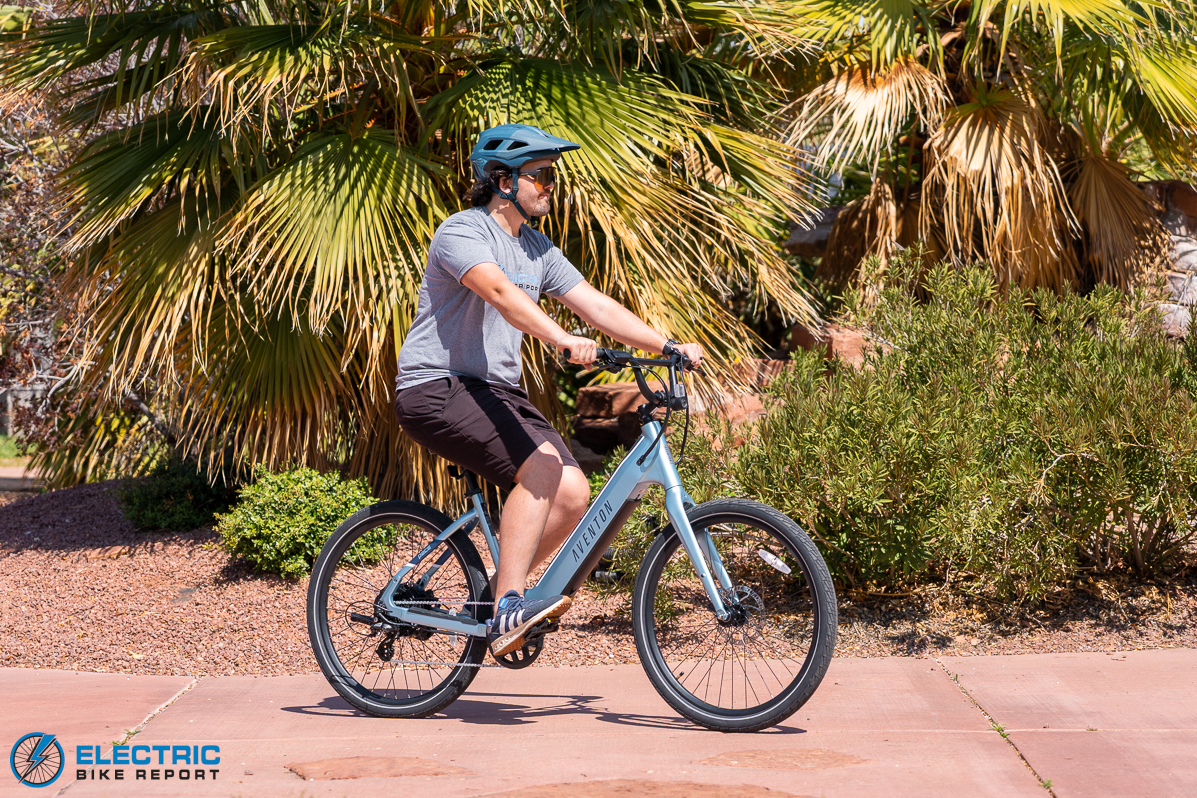
The Pace’s step-thru frame is available in two sizes and is recommended for riders from 4’11’ to 6’1”. We tested the L/XL model.
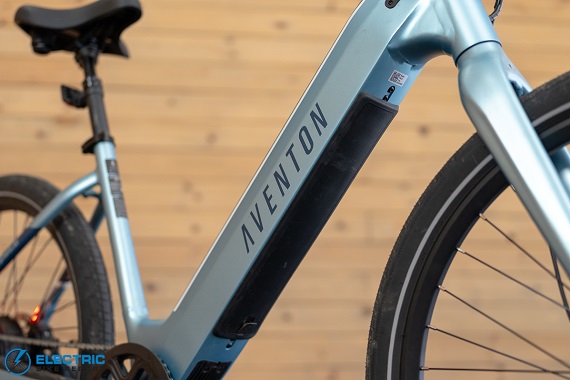
The 36V, 733-Wh battery is locked in the down tube until ejected using the bike’s display or the Aventon app.

The Pace 4’s hydraulic disk brake system performed well in our testing and stopped the bike reliably.
Aventon Pace 4 Review: Brake Test

We tested the Pace 4’s Tektro HD-T3020 hydraulic brake system using the above method and determined its average stopping distance to be 20’8”. The bikes’ result is over a foot and a half better than the commuter/city cruiser category average of 22’4”.
When trying to determine why the Pace did so well, nothing stood out as being obvious. Its weight of roughly 62 lbs and 27.5×2.1” street tires are all relatively average for this style of bike. It’s possible that the brake system itself was a contributing factor, as the Tektro T3020 system has not been as common on e-bikes we’ve tested as other models from Tektro, but it’s hard to say with certainty.
As the numbers indicate, this brake system performed extremely well. Anecdotally, I’d say it felt better than average; it modulated my speed well, and it applied braking force intuitively.
With that said, I admit that I was somewhat disappointed by one aspect of the bike. The Pace 4 has taillights but not brake lights, which largely comes down to the Tektro T3020 system not having a motor cutoff feature. Overall, I don’t think a motor cutoff is needed on bikes with torque sensors, but I do think brake lights would make the bike safer overall.
Otherwise, I was happy with the brake system, the fact that the bike has turn signals, and the Pace’s overall score in this test. I don’t think any changes are needed, and I can say the brakes felt safe and effective.
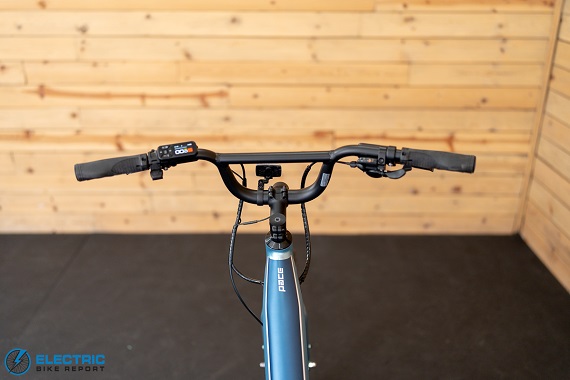
The 720mm BMX-style handlebars gave the Pace 4 a youthful and sporty feel.
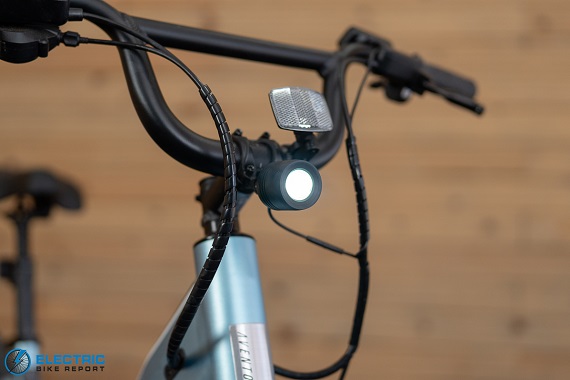
An integrated LED headlight helps out with visibility and illumination at night.
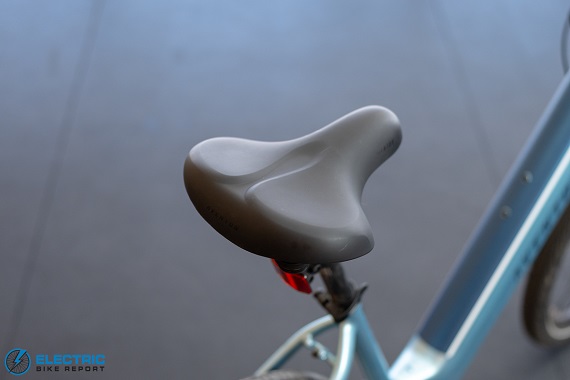
The bike’s wide, cruiser-style saddle offers plentiful support and a comfortable ride.
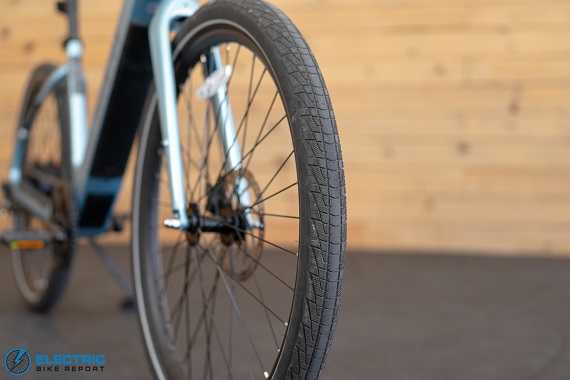
The 27.5×2.1” tires roll smoothly for quick acceleration and efficient energy use.
Aventon Pace 4 Review: Ride Quality
The Pace 4 is available in two frame sizes: an S/M frame intended for riders between 4’11” and 5’7” and an L/XL for those between 5’7” and 6’1”. We tested the L/XL frame, and at 5’11”, I am well within the bike’s recommended height range.
The bike’s suspension seatpost offers 50mm of travel for cushioning and has roughly 5” of adjustment for saddle height. I was able to set the saddle comfortably for proper leg extension, and the bike’s geometry put me in a mostly upright position with a slight forward lean and my arms outstretched on the BMX-style handlebars.
Having recently reviewed the Aventon Level 3, which has a more aggressive forward lean appropriate for a dedicated commuter, I found the Pace 4’s more relaxed positioning generally more comfortable. I was, however, somewhat surprised by the bike’s sporty feel, which is a significant departure from the firmly upright, cruiser-influenced design of previous Pace models.
Riders new to the Pace line likely won’t think twice about the changes, but owners of older models such as the Pace 500.2 or 500.3 who enjoy that bike’s style may be caught off-guard. Such riders may want to consider swapping to a set of Dutch-style cruiser handlebars and possibly also a stem with more rise.
Great handling has always been a major highlight of e-bikes in the Pace line, and I’m happy to report that this new bike continues the trend. Like its predecessors, the Pace 4 felt zippy and agile, with crisp cornering and a generally sturdy frame. Both of the latter aspects of its handling are benefits of a rigid aluminum fork and the bike’s gravity-cast frame.
The Pace 4 rolls on relatively smooth and efficient 27.5×2.1” street tires. These tires add some cushioning while offering great stability and traction on paved surfaces.
As mentioned in previous sections above, the Pace has a highly responsive motor with power levels ranging from light to ample. It adapted quickly to changes in the amount of pressure I put on the pedals, resulting in an incredibly natural pedal experience that I’ve come to associate with Aventon bikes (and a few other brands).
One additional strength of this bike is its overall simplicity, at least at face value. The app and many of its security features can add a layer of complexity along with a learning curve, but considering that the battery and wheel locks can be accessed through the display, they’re not absolutely necessary. I do recommend setting up a passcode on the display for those who opt out of using the Aventon app.
For those who wish to take advantage of the additional features granted through the app, I highly advise taking some time to familiarize yourself with all it has to offer. Our video review (linked above) includes an app walkthrough that explains all of the customization options and security features, though I’ll give a brief explanation of many of them below.
The first thing to note is that a subscription is required to get the most from the app and the Pace 4’s integrated 4G chip. Aventon charges an extremely reasonable $20 annually or $2 monthly for the service, which allows for GPS location tracking and remote disabling of the bike in the event of theft, among other things.
The combination of the ACU and the app allows users to set up a motion detection and alarm system with three sensitivity settings. If the bike is moved or jostled, it will send notifications to the phone of the user it is paired with.
The bike also has geofencing features that make it great for parents who want to monitor their child’s location. Users can set allowed or prohibited zones using GPS; if a rider enters a prohibited area or leaves an allowed zone, the bike’s pedal assist system will deactivate, and an audible (though relatively quiet) alarm can be set to sound.
Users can choose to enable a setting that will deactivate the bike if it is not turned on and allowed to connect with Aventon’s servers within a set time frame. The app also offers a power-saving Transport Mode that reduces the ACU’s draw from the battery and disables the motion detection system when moving the bike with a larger vehicle.
In short, the Pace 4 includes a myriad of cool, high-tech features that are nearly unheard of at its price point. We’ve tested a handful of e-bikes with similar locks, alarm systems, and 4G connectivity, but most have been priced significantly higher—in some cases, over six times above Aventon’s pricing for the Pace (at the time of writing).
To reiterate, the Pace 4 can be a simple and straightforward e-bike, but the Aventon app encourages a more connected approach that gives users a high degree of control over the security of their investment. I enjoyed the bike’s overall feel and experience without the app, but the ACU cranked its ride quality up to 11!
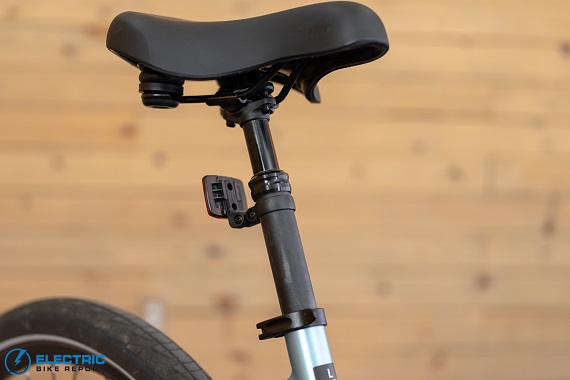
The included suspension seatpost has 50mm of travel to prevent bumps from disrupting your derrière.
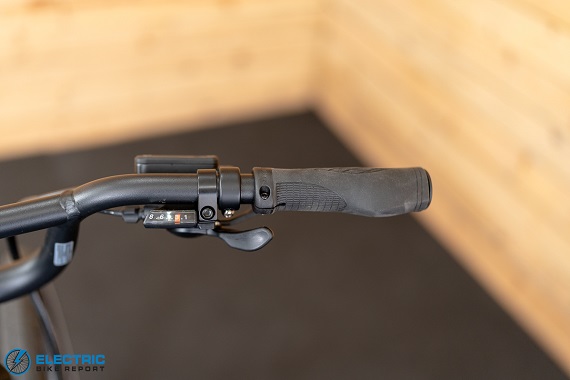
A rapidfire shifter sits below the handlebar next to the right ergonomic rubber grip.
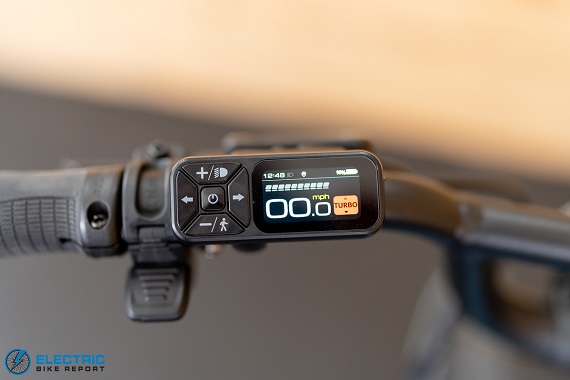
The combination display/control panel is small and generally readable, placing all of the buttons within easy reach of the left grip.
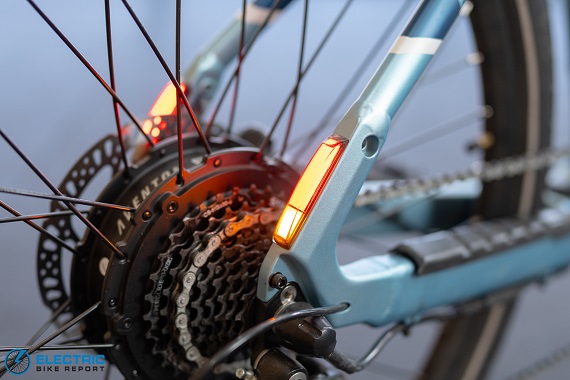
Aventon continued the trend of using seat-stay-integrated taillights with turn signals.
Aventon Pace 4 Review: Summary / Where to Buy
But back to the basics, the Pace 4 performed extremely well in all areas of our testing, proving that Aventon’s experience is going to good use. It demonstrated excellent range, great stopping power, solid hill climbing ability, and an intuitive, customizable, and precise pedal assist system.
After reviewing previous versions of the Pace, I was admittedly thrown off at first by the 4’s differences in geometry and riding position, but more time in the saddle gave me a fresh perspective. I think this new version of the bike offers a fun, responsive, sporty, secure, and comfortable ride that’s chock full of value.
Clearly, Aventon went in the right direction with the Pace 4’s updates, though potential buyers—especially owners of previous models looking to upgrade and expecting the same feel—should be aware that some changes may be necessary to get closer to that. And while I’m happy to see the Pace 4’s integrated turn signals, I hope Aventon brings back the brake light functionality in the future for an extra layer of safety on the road.
Otherwise, the Pace 4 is a great e-bike that’s well-suited for evening cruises around the park or neighborhood. We recommend it for those who enjoy riding a “regular” bike but want something that requires less effort. We also recommend it as a lighter long-range commuter for those who like the Level 3 but prefer a more relaxed riding position.
Happy Riding! Make sure to let us know if you have any questions or if you think we left anything out in this review of the Aventon Pace 4 down in our comments section.



got a pace 4 in Sept 2025 from dealer in eagle river Wisconsin and it has brake lights that work well
Interesting! What brake system came on your bike?
Just purchased mine from Barney’s Bike Shop in Worcester. It has the brake lights, and he’s swapping out the handlebars for me for the Dutch Style type. I’m only 4’11” and the reach on the BMX style handle bars was too much of a reach for me. Makes a ton of difference.